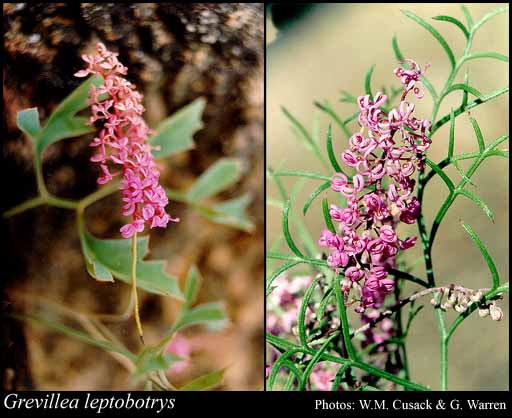- Reference
- Lehm., Pl.Preiss. [J.G.C.Lehmann] 2:256-257 (1848)
- Conservation Code
- Not threatened
- Naturalised Status
- Native to Western Australia
- Name Status
- Current
Sprawling, prostrate or spreading, non-lignotuberous shrub, 0.15-0.4 m high. Fl. pink, Jan or Jun to Jul or Sep to Dec. Sandy, gravelly, loamy or clayey soils on laterite or granite.

Scientific Description
Shrubs, 0.1-0.5 m high; branchlets glabrous or hairy, not glaucous. Leaves alternate, 30-290 mm long, hairy or glabrous, on the adaxial or abaxial surface, the hairs straight; lamina flat, twice or more divided, pinnately divided, divided to the midrib; lobes 20-50 mm long, 10-20 mm wide, the margins recurved or revolute, exposing the lower surface of the leaf blade or enclosing the lower surface of the leaf blade, forming a groove either side of the midvein. Inflorescences terminal, pink; pedicels 3-8 mm long. Perianth 2-3 mm long; tepals all free after flower opens, glabrous or hairy, simple-hairy; ovary glabrous, stipitate, the stipe 0.5-1.5 mm long; pistil 3-5 mm long, pink, pollen presenter conical, style glabrous. Follicles glabrous, not viscid, dehiscent, 9-14 mm long. Flowers in October, November or December. Occurs in the South-west (SW) Botanical Province(s), in the Swan Coastal Plain (SWA), Avon Wheatbelt (AW) or Jarrah Forest (JF) IBRA subregion(s).
Distribution
- IBRA Regions
- Avon Wheatbelt, Jarrah Forest, Swan Coastal Plain.
- IBRA Subregions
- Katanning, Northern Jarrah Forest, Perth, Southern Jarrah Forest.
- Local Government Areas (LGAs)
- Armadale, Beverley, Boddington, Boyup Brook, Brookton, Busselton, Collie, Cranbrook, Cuballing, Kojonup, Manjimup, Narrogin, Pingelly, Wandering, West Arthur, Wickepin, Williams, York.